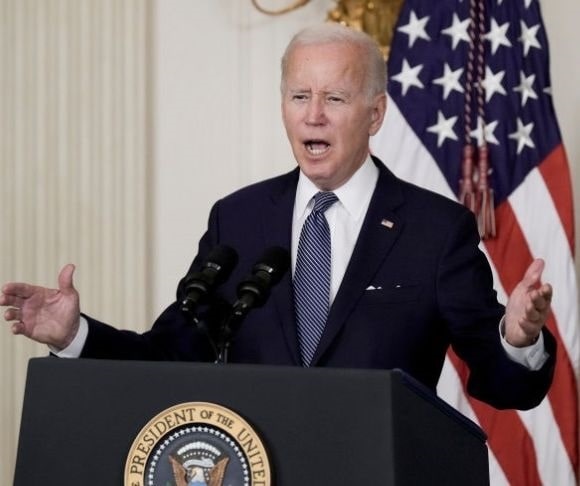Recently, a Washington, DC, newspaper published a 10,000-word essay on the Ukraine crisis entitled, “Road to war: US struggled to convince allies, and Zelensky, of risk of invasion,” by Shane Harris, Karen DeYoung, Isabelle Khurshudyan, Ashley Parker, and Liz Sly. The article’s central point, however, is misleading. The narrative paints the Biden administration’s national security and foreign policy before Russia’s unprovoked attack on Ukraine as a “struggle” to convince Kyiv of the imminent invasion. The takeaways are often misrepresented as the Biden team’s legitimate policy pains to bring allies and Ukraine’s President Zelensky to a realistic understanding of the impending peril of the Kremlin at Kyiv’s doorstep.
That is not what the American people or US allies observed from the Biden administration. When Zelensky pleaded for NATO to take notice of the build-up of Russian combat troops on Ukraine’s eastern border, the US was silent. Zelensky, in the Spring of 2021, did not have to be persuaded. “The Kremlin’s persistent and growing presence of combat troops and equipment to the north and east of Ukraine is an intensifying concern,” Liberty Nation reported.
Ukraine Crisis Obvious from the Beginning
Missing from the article was emphasis on the expanding threat facing the Zelensky government in April 2021. As time passed until the attack, the number of Kremlin combat forces grew to over 170,000 engaging in hostile maneuvering in Belarus and to the east on the Ukraine frontier with Russia. In June 2021, President Biden held his first face-to-face summit meeting in Geneva with Russian President Putin. Following the world leaders’ discussion, a curious thing happened. “The Biden White House has temporarily halted a military aid package to Ukraine that would include lethal weapons, a plan originally made in response to aggressive Russian troop movements along Ukraine’s border this spring,” Politico revealed. Holding up desperately needed arms doesn’t suggest the US took the invasion threat seriously, but instead chose to toady up to the Kremlin.
On the other hand, instead of some reciprocal gesture to the stopping of weapons to Ukraine, Putin issued his 6,685-word manifesto on July 12, 2021, telegraphing his intentions to absorb Ukraine into Mother Russia and explaining why he would do so. Putin’s plan was not ambiguous. But the US administration and the American media gave little mention to the Russian leader’s strategic campaign to annex Ukraine.
Not until November did the White House provide weaponry to Ukraine that was more than just defensive. As the Washington-based newspaper points out, the resumption of a modest flow of lethal weapons began after a seminal meeting in the White House between the president and his key national security staff. From the article’s explanation, seven months after the assembling of the Russian invasion force, Biden received from his national security staff convincing evidence Putin was serious about taking Ukraine back.
However, for all of the Oval Office conversations and behind-the-scenes discussions with NATO and European Union allies from October 2021 to February 24, when Kremlin forces attacked across Ukraine’s borders, the US, NATO, and other European nations did not provide effective, offensive combat weapons. They sent defensive weapons, mostly anti-tank and anti-aircraft missiles. So, if the US was convinced of the invasion’s imminence, why wasn’t there more enthusiasm for preparing Ukraine’s forces before February 24? A partial explanation can be found in a quotation from the Harris et al. piece, which says more about the Biden administration’s thinking than the article suggests.
Biden Talks Past Zelensky

Volodymyr Zelenskyy (Photo credit should read Yevhen Kotenko/ Ukrinform/Future Publishing via Getty Images)
On that point, one exchange between Zelensky and a US official is evocative. “You say a million times, ‘Listen, there may be an invasion.’ Okay, there may be an invasion – will you give us planes? Will you give us air defense?” Zelensky said. The US official responds, “Well, you’re not a member of NATO.” Zelensky replies, “Oh, okay, then what are we talking about?” The short conversation reveals the Biden administration simply was not responding to the reality Zelensky knew up close and personal. If an invasion was coming soon, Zelensky needed weapons to address the attack, not a repetition of the warning. Typical of the Biden team, it says what it wants to say and hears what it wants to hear so it can do what it wants to do.
Furthermore, if the US administration had evaluated the Ukraine crisis more closely before February 2022, it would have realized, regardless of what the American intelligence community said, there would be skepticism regarding its veracity. The article did not hold back on this aspect of Biden’s handling of the Ukraine crisis. “American intelligence is not considered to be a naturally reliable source. It was considered to be prone to political manipulation,” explained Francois Heisbourg, a longtime advisor to French officials on security subjects. The credibility of the Biden administration was seriously hobbled after its failure to heed the intelligence resulting in its Afghanistan withdrawal debacle. The impression was that the US president did not believe his intelligence community. Consequently, if the White House doesn’t have faith in its intelligence information, why should anyone? Intelligence information is fragile, and once called into question, regaining confidence in data and sources is difficult.
If, as the authors posit, the White House struggled to convince allies and Kyiv’s leadership of an impending Russian invasion, it was a struggle of its own making. The nine months leading up to Putin’s attack were replete with indicators of the Kremlin’s objective. Harris et al. presented one historical perspective from inside the White House. Americans and the rest of the world observed something different.
The views expressed are those of the author and not of any other affiliation.




